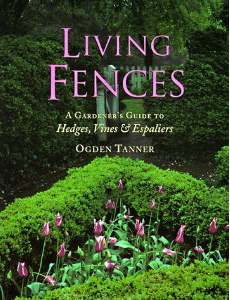
Living Fences
 Long-time
readers will know that I'm interested in hedges, even though I haven't
really experimented much with them. I like the idea of planting a
living barrier that will keep deer out and chickens in even after our
metal fences rot into the ground. It would be a major bonus if
that barrier also produced food for the chickens and for us. So I
was thrilled when I stumbled across Living Fences: A Gardener's Guide to Hedge's, Vines, & Espaliers, by Ogden Tanner, in our local library.
Long-time
readers will know that I'm interested in hedges, even though I haven't
really experimented much with them. I like the idea of planting a
living barrier that will keep deer out and chickens in even after our
metal fences rot into the ground. It would be a major bonus if
that barrier also produced food for the chickens and for us. So I
was thrilled when I stumbled across Living Fences: A Gardener's Guide to Hedge's, Vines, & Espaliers, by Ogden Tanner, in our local library.
Unfortunately, the book
isn't really what I was looking for (which I suspect might not exist),
since it's mainly a list of species you might want to use in ornamental
living fences, along with some data on their construction from a
landscaper's point of view. However, I did find some information
that will be helpful when I finally get our borders weed-free enough
that I can start my hedge experiments. Here are species that might
make the cut:
| Species |
Features |
Spacing in a hedge |
Questions |
| Flowering quince (Chaenomeles speciosa) |
Thorny barrier; edible fruits; informal hedges 4-6' tall |
2.5-4' |
Can fruiting quinces be used the same way? |
| Cornelian cherry (Cornus mas) |
Edible fruit; informal or form hedges 4-15' tall |
1-4' |
|
| Cockspur hawthorn (Crataegus crus-galli) |
Thorny barrier; informal hedge up to 30' tall |
3-4' |
Would fruits be edible to chickens? |
| European beech (Fagus sylvatica) |
Classic European hedge plant; formal or informal hedge 6-20+' tall |
2-10' |
Would American beech work as well? Can chickens eat their nuts? |
| Beach plum (Prunus maritima) |
Edible fruits; informal hedge 6-10' tall |
3-6' |
|
| Alpine currant (Ribes alpinum) |
Withstands shade; formal or informal hedge 2-5' tall |
2' |
Will more tasty currants and gooseberries work in a hedge? |
| Roses (Rosa sp.) |
Some have edible hips; informal hedge 6-7' tall |
2' (or 3-6' for Rosa rugosa) |
And, of course, if I want
to screen off an area but don't need the plants to repel animals, I
could use vines alone fencelines instead. Top edible vines include
hardy kiwis and grapes.
If you'd like more information on hedges, I've made a few other research posts, and also reported on an ill-fated osage-orange experiment.
(The conclusion to the experiment was: trying to start a hedge in an
area that's currently covered in tall weeds and young trees just doesn't
work.) Here are the research posts to get you started:
- Gene Logsdon on trees along fencelines
- Traditional British hedges
- Bouche-Thomas hedges (really an espalier)
- A previous species list of potential edible hedge plants
If you've experimented
with edible hedges and/or hedges used as livestock fences (or have found
a good source for information about them), I'd love to hear about it!
Want more in-depth information? Browse through our books.
Or explore more posts by date or by subject.
About us: Anna Hess and Mark Hamilton spent over a decade living self-sufficiently in the mountains of Virginia before moving north to start over from scratch in the foothills of Ohio. They've experimented with permaculture, no-till gardening, trailersteading, home-based microbusinesses and much more, writing about their adventures in both blogs and books.
Want to be notified when new comments are posted on this page? Click on the RSS button after you add a comment to subscribe to the comment feed, or simply check the box beside "email replies to me" while writing your comment.

The first year we bought fruit for our backyard we bought a gooseberry plant and it is the only plant that has thrived with the root competition of a nearby tree and with little help from us. I also mulched it heavily last year and everywhere a branch accidentally got mulched over it rooted. I would think gooseberries would be a nice tough plant to try as a hedgerow. Most of the cuttings I took last year rooted and we are going to plant them near the first one to form a hedge in that area.
You may have read this before but just in case you haven't, here is an article from Mother Earth Magazine that I read some time ago.
http://www.motherearthnews.com/homesteading-and-livestock/living-fences-zmaz10onzraw.aspx#axzz2l1VBTp54
I've been doing some research on multi-purpose barrier plants recently and came across Sea Buckthorn (Hippophae rhamnoides) that apparently grows tall, has thorns that can keep out larger pests like deer, and makes edible berries. I've heard differing stories about whether or not they are easy to cultivate, though.
I ordered some sold stratified seeds from a small outfit in Massachusetts and tried to direct seed in autumn. Nothing so far, but maybe we'll see some growth in spring. We're also going to try growing some starts in late winter.
I have a japanese quince outside my front door. It grows like nobody's business and it has the most striking pink flowers in the lat winter/early spring. It does fruit, and from what I understand the fruit is indeed edible. This website: http://www.laughingduckgardens.com/ldblog.php/2013/10/28/the-other-quince/ has information on canning/preserving the fruits. This website: http://doctorschar.com/features/japanese-quince-chaenomeles-japonica/ has some other interesting info.
I don't use it as a hedge, but it grows so thickly and it has some mean spines on it! The birds of the neighborhood like to use it to hide from my cat.